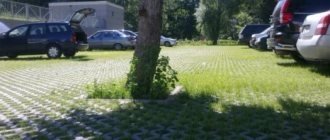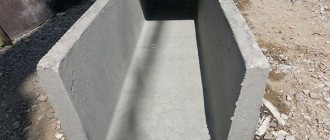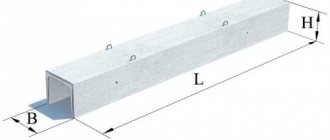An indispensable element of road construction is the drainage system; drainage trays are the basis for draining moisture from highways. Manufacturers offer more than a hundred ranges of concrete drainage trays. All of them are united by an inexpensive price, ease of installation and convenient ability to order. Precast concrete factories in Russia necessarily add concrete drainage trays with a wide range of sizes to their catalog of products.
Concrete tray with straight sides
The choice of methods to combat soil waterlogging in road construction sites is quite limited. Concrete drainage trays have become widespread due to their ease of use and reasonable price. We also mention the large assortment, variety of designs and wide selection possibilities for projects of different sizes.
A concrete drainage tray is the most popular and inexpensive way to create a high-quality moisture drainage system from the highway. Trays with gratings create a controlled drainage of rainwater and protect the road surface from the negative effects of moisture.
Design Features
According to the shape and geometric characteristics of the section, the trays are divided into:
1. Box-shaped ( K ) - concrete body and top, covered with a storm grate. The most popular in construction.
If you look at a cross-section of such a concrete drainage tray, then most often the structure has a U-shaped section. You can also find a U shape in the description.
Rounding radii and slight wall slopes are acceptable.
2. Slotted ( Shch ) - closed trays with narrow slotted openings for the passage of water.
2. Curb-slot ( BShch) - a closed type profile with one strip for rainwater drainage.
3. Open Trays ( O ) – Open Trays are an open top body only design.
The material for the drainage tray is selected from waterproof and durable grades of concrete. For reinforcement, reinforcing steel is selected in accordance with the requirements of construction standards and regulations.
⇒ Open trays require additional components: special sand traps and protective grilles.
GOST 32955-2014
The concrete drainage tray is subject to a standard state document - GOST 32955-2014, which contains basic information on the product. It defines design schemes, requirements for materials and operating conditions.
Full name GOST 32955-2014. Public roads. Road drainage trays. Technical requirements
GOST is the main document for the design and selection of trays for storm drains.
Concrete trays with gratings
The reinforced concrete drainage tray is equipped with gratings. Cast iron, steel or plastic gratings are installed on top of the sides. In a number of ranges, special stops are provided for better fastening of the grille.
The main purpose of the grille is to protect the storm drainage system from large debris. Plastic bags are the scourge of modern storm sewers. They tightly clog both the tray itself and the sand trap. Thus, the drainage system in the area is disabled.
It is difficult to imagine a pedestrian or automobile road without a concrete tray with a grid. Open structures cause injuries to pedestrians and cyclists and are also unsafe for cars. A stuck wheel in an open tray can cause a lot of trouble.
Grids, as well as trays, are selected according to load classes. Concrete trays of a high strength class are equipped mainly with cast iron “strong” gratings. For classes A - C, plastic grilles are also acceptable.
Typically, manufacturers offer concrete trays complete with gratings at a reduced price. It is cheaper to buy a concrete drainage tray assembled in a grid.
Sand traps for drainage trays
Storm drainage trays must be equipped with sand traps. In general, a sand trap is a specially designed unit that purifies rain, waste and melt water from dirt and sand.
In road construction, a form of sand traps is called wells. Usually this is an independent element of the drainage system.
Reinforced concrete products are in great demand
The entire stormwater main, including the vertical one, is equipped with gratings. They protect against leaves and large debris and perform a safety function. The gratings are tightly attached to the trays with special fasteners; if necessary, they can be dismantled for cleaning.
The material from which the grate will be installed is directly related to the location of the sewage system for melt water and precipitation and the possible load on it.
Application area
Concrete products are installed exclusively in companies with a hard, even surface.
- On pedestrian sidewalks with asphalt or tiles
- On concrete areas (airfields, ports, military facilities)
- In vehicle parking lots
- At gas stations
- In the central squares
- In industrial areas
- Near infrastructure buildings.
The production of concrete channels occurs in two ways
- Vibrocasting. The form filled with mortar vibrates, which allows the concrete to shrink well and remove excess air.
- Vibration pressing. Using a press, the concrete solution is compacted.
Types of channels
- Channels can be linear or vertical; the protective coating for them is made of cast iron, steel, and plastic.
- Cast iron gratings are mostly galvanized to reduce corrosion.
- The disadvantage of cast iron products is that they are often stolen. For this reason, most of them are equipped with additional locks.
- Steel products are made of stainless steel, sometimes the surface is galvanized.
- Plastic tray protection is made from heavy-duty materials.
- The design on the external part of the sewer system is usually standard, but it can also be decorative.
Decorative grilles are installed in public places where it is necessary to maintain style. The type of products with a pattern is cast mainly from copper. Copper is a soft metal, for this reason gratings are installed where there is no heavy load (on point storm drains under roof gutters, in front of the front entrance of buildings, etc.)
- If desired, you can make custom-made grates from cast iron with a pattern - forged. The service is expensive. It is mainly used by owners of private houses.
- Standard types of gratings include slotted cast iron and cellular.
- Slot-type products are best installed in areas with maximum load.
- Concrete gutters with grating are used for the installation of storm sewer mains, for laying various types of electrical cables, and for heating mains.
- Trays are available with or without slope.
Gutter dimensions
Length of all products 1m
Width 0.14 – 4 m
Height 0.06 – 1.68 m
The most common volumes of reinforced concrete trays: 0.07 cubic meters, 0.14 cubic meters, 0.3 cubic meters.
Release form
- Trapezoidal
- U-shaped
- U-shaped
Concrete drainage rain tray is produced in accordance with the European standard EN 1433 and GOST.
Product advantages
- No corrosion
- Long service life
- Resistance to temperature changes
- Increased strength
- Heavy weight (guarantee of immobility under high loads)
- Environmentally friendly material
- Does not require careful maintenance (just clean from debris)
- Decent price-quality ratio
- Heavy weight
- Special equipment required for installation
- Installation is labor intensive
Comparison of plastic and concrete trays
When designing a road drainage system, engineers are inevitably faced with the agonies of choosing chute materials. Plastic and concrete trays have their advantages and disadvantages. In each specific project, it is necessary to select a tray depending on operating conditions, precipitation levels and more than a dozen other factors. The project budget also plays an important role.
| Concrete | Plastic | |
| Price | from 500 rubles for 1 piece. 0.5 meters long. | from 400 rubles for 1 piece. 0.5 meters long. |
| Ease of installation | A small amount of concrete is required for pouring during installation work. | A fairly significant amount of solution is required when installing a plastic drainage system. |
| Behavior in the cold | Concrete retains its shape during frosts and temperature fluctuations. | Depends on the quality of the plastic. “Good, expensive” frost-resistant plastic remains elastic at low temperatures. |
| Unloading-loading | The product is quite heavy and requires careful transportation, as it is sensitive to shock loads due to the possibility of cracking. | Does not cause problems, the product is lightweight and convenient for unloading work. |
| Resistance to mechanical stress | When hit by heavy vehicles, the concrete tray can withstand pressure without damaging the body of the tray. | With proper installation of the drainage system, the tray itself does not experience loads from cars. The force will be distributed to the concrete pad and grating. |
| Number of freeze-thaw cycles | A lot of | A lot of |
| Performance | If installed correctly, the likelihood of breakdowns is almost zero. | Sensitive to installation accuracy. High-quality installation can significantly extend the service life of the tray. |
Advantages and disadvantages
Concrete gutters have the following positive properties:
- Low price.
- Chemical resistance.
- Corrosion resistance.
- High degree of strength.
- Waterproof.
- Resistance to temperature fluctuations.
- Integrity of the structure.
- Versatility of use.
- The smooth surface facilitates efficient removal of debris.
- The product is environmentally friendly.
- There is no replacement at a lower cost.
- The installation of the system in private construction does not require significant installation and excavation work.
- Long service life (more than 50 years).
The disadvantages of the design include:
- The large mass makes installation of gutters difficult.
- High cost of transporting trays.
Advantages of concrete drainage trays
The main advantages of concrete products are obvious: high resistance to loads, temperature and humidity changes, ease of installation and replacement, environmental friendliness and durability.
- Create thermal insulation properties that retain heat in the pipeline.
- Protects against alkaline and chemical reagents.
- Prevents physical wear and damage to pipes, as well as damage to pipes by rodents.
- Drainage trays made of concrete and reinforced concrete can be installed on soft soils with high groundwater levels
Installation of a drainage system
Tools and materials:
- shovel;
- hammer;
- hacksaw;
- hand saw with diamond blade;
- concrete;
- drainage trays;
- gratings;
- acrylic based sealant.
Instructions:
Linear drainage diagram.
First, based on data on the drainage area, the amount of precipitation and the type of surface (asphalt, soil, sand, etc.) where the installation will be carried out, a diagram of the planned drainage system is drawn up and models of drainage gutters are selected to eliminate the possibility that the drains are not cope with the volume of water. It is also worth considering the degree of physical activity and the composition of the water; in special cases, the drainage is treated with a special agent that protects the surface of the tray from an aggressive environment. Typically, drainage is installed around the perimeter of the house, site and next to the garage
It is not necessary to follow exactly this plan; it is important to understand that the installation of the system should occur where it is needed. Following the approved scheme, prepare the channels where the trays will later be installed. For maximum accuracy, channels are marked on the surface with a marking cord
A concrete base (10 cm) must be installed at the bottom of the channels. The width of the channels should be 20 cm greater than the width of the tray, and the depth should be such that after installing the drainage system, the storm grates are approximately 5 mm below the level of the surface into which the installation is taking place. There should be a sewer drain at the lowest point of the system. Drainage trays are laid in the center of the prepared channels, and the remaining space around the edges is filled with concrete. Fastening metal gratings to drainage systems. If necessary (for example, at corner joints), the gratings are sawed with a saw with a diamond blade.
The system can be installed either with or without a sand trap, and the connection to the sewer drain will in the first case go through the sand trap, in which the plug must be knocked out before installing it. If the sand trap is not used, you can cut a hole in the tray for drainage. In plastic trays there is a special place for fastening to a sewer pipe, and in a concrete tray you need to drill a hole along the contour in several places, and then knock out the excess part with a hammer from the inside.
To create corner joints from concrete trays, you need to use a saw with a diamond blade, and if you need to create an angle of 100 degrees, you need to cut off the corners of 50 degrees on the joining trays, that is, the angles on the joining trays must be equal. The cut is made by capturing both walls of the tray. The joints of the trays are sealed with acrylic sealant.
Methods for making drainage trays
The main method of manufacturing concrete trays at reinforced concrete factories is vibration casting. This method eliminates the formation of internal defects (voids, cavities, pores). This is not direct concrete casting, but a special pressing technology using vibrations. Concrete drainage trays made using vibropressing technology have increased strength characteristics.
The technology for producing drainage trays at different factories may differ slightly. Production capacities dictate their own rules and this cannot but affect the quality.
Modern industry offers improved technologies for producing drainage systems. Reinforcement or hardening of concrete occurs with special fiberglass or fiber fibers. Such trays not only have the characteristics characteristic of “ordinary” reinforced concrete, but are characterized by lower weight, lower price and increased strength characteristics. A progressive and high-tech enterprise must follow new trends and “trends” in the field of reinforced concrete products.
Within the huge plant, manufacturing technology is 100% followed and all standards are met. When choosing drainage trays, you should first look at the manufacturer. In Russia, the production of high-quality trays has been established in many factories. One of the leaders is a manufacturer of reinforced concrete products from Safonovo, Smolensk region. The full catalog is presented here.
Permissible load
Based on the specific operation of these products, associated with constant mechanical loads on the structure, this parameter is key. Below is a table of tray classification.
| Type | Permissible load (t) | Scope of application |
| A15 | 1,5 | Summer cottages, pedestrian and park areas, sports grounds, etc. |
| B125 | 12,5 | Private households, parking lots, garage cooperatives, roads for cars. |
| S250 | 25,0 | Car washes, car service companies, gas stations, etc. |
| D400 | 40,0 | Automotive enterprises, industrial zones, transport terminals, as well as roads with high passenger and cargo traffic. |
| E600 | 60,0 | They are installed on drainage systems of warehouses, logistics centers, large industrial enterprises, and berths. |
| F900 | 90,0 | Military bases, airfields, and places where heavy equipment is used. |
Drainage trays dimensions
The symbols of the products will help you understand the sizes of concrete trays. There are various series of trays, which are designated according to Russian or European standards.
DN standards for drainage channels
Nominal diameter DN - nominal diameter; conditional pass; nominal size; a mandatory parameter for joining the connected parts of the drainage system. DN - is an average value for the convenience of choosing a tray. Averaging is always upward.
DN 150, where DN is the nominal diameter, 150 is the diameter in millimeters, designation of the internal width of the gutter in millimeters.
Numbers for European standards DN - 100, 150, 200, 300, 500. In Russia DN110, 160,
Sometimes it is indicated “through a fraction” - for example, DN 300/185. In this case, the second number is the depth of the gutter in mm.
L is the length of the section. The Energomonolit catalog presents concrete trays with sizes from 500 to 3,000 mm. To order, we produce elongated copies up to 6 linear meters and shortened “extra” ones - 50-70 centimeters.
B is the outer width. Depending on the DN dimensions and wall thickness, dimensions range from 400 to 1900 mm.
H - depth or external height of the product. Size range from 380 to 1,500 mm.
In the catalog of each manufacturer, the weight and dimensions of the tray, with or without a grid, are indicated in the metric system in a table or product card.
Trays DN100, DN 200, DN 300, DN 400 of various strength classes can be ordered here.
Load classes
The load-bearing capacity is determined by the value of the test force in kN per square meter. For practical use, it is convenient to convert kN to tons. 1 kN ̴̴ 0.1 tons.
One ton will exert a force of 10 kN.
Load classes of surface drainage are usually designated by letters of the Latin alphabet from A15 to F900 with a numerical designation of the withstanding force. A total of 6 classes or mounting groups are used.
- A 15 (up to 1.5 tons) - lightweight trays are usually installed under sports and children's playgrounds. Also used in urban pedestrian areas. With a small expected load, class A trays can be found on bicycle and park paths, in suburban areas (under garden paths);
- B 125 (up to 12.5 t) - installation under car paths for cars, in parking lots, in front of a country garage and in a city garage cooperative is allowed;
- From 250 (up to 25 tons) - used at gas stations, car washes, and car service stations;
- D 400 (up to 40 tons) - common in industrial zones, automobile enterprises, and on roads with possible traffic of all types of transport;
- E 600 (up to 60 t) - are used in industrial enterprises, logistics centers, warehouses, and roads with high traffic volumes;
- F 900 (up to 90 t) - super heavy class. Used at airfields, ports, docks and military bases.
Depending on the expected load, the type of tray is selected. Also, the intensity of traffic must be taken into account. Load classes must be indicated in the accompanying documentation for the products.
Device
The assembly of open sections of rainwater drainage systems is carried out from special elements that are capable of independently receiving and moving runoff in the desired direction. These elements are laid flush with the ground surface so that water can flow freely into the system. Compared to closed networks, this method of drainage is much simpler and cheaper.
Reinforced concrete trays for storm drainage are gutters connected in a continuous line. It connects stormwater inlets or other reservoirs to the collector. Another option is to supply wastewater to a discharge point into a reservoir. The upper part of the trays can be covered with a decorative lattice, and large products can be covered with a solid reinforced concrete slab. This is done to protect the tray from debris, foreign objects, people or animals. Plates for storm drainage are produced together with trays of a certain size and form a single set.
The design of the gutters is a rectangular or smoothly rounded tray at the bottom through which the drains move. The products are used for collecting and supplying wastewater in areas of external and internal rainwater drainage. The main advantage is the simplicity of the design, the ability to repair or restore the trays. They are often made with their own hands, using simple homemade molds for casting.
The network is assembled by sequentially laying gutters in a line. This allows you to ensure maximum filling of the reinforced concrete storm sewer tray and eliminate leaks.
Transportation Features
When ordering delivery of concrete trays, please note that the weight of one product can reach 50 kg. On average, concrete trays weigh about 23-30 kg.
Concrete drainage trays are sensitive to improper transportation. They may simply break or “crack”.
At our factory, we group the trays and bundle them in a special way. Delivery is carried out by our own trucks.
Is it possible to make concrete drainage systems yourself?
Today, the price for this type of equipment in Russia fluctuates between 160-170 rubles/piece.
If you don’t want to spend a lot and have enough time, you can try making concrete drainage trays with your own hands.
If you strictly follow the instructions, then everything will definitely work out.
DIY concrete drainage tray
So, the arrangement of storm drainage begins with the preparation of design documentation.
Next you will need to take the following steps:
- prepare equipment and engine oil for filling.
The molds can be plastic or metal, their base is lubricated with oil, after which the fittings are installed inside; Mold for pouring concrete trays - It is worth noting that metal wires must be secured by welding, and the ends should not protrude from under the cement;
- After pouring the concrete mixture, the forms are fixed and remain in a certain position until it hardens. This ensures maximum surface evenness;
- after a week, pull out the formed channel (carefully), if necessary, treat it with paint to ensure the smoothness of the surfaces.
Formed concrete tray
Remember! If you strictly follow the manufacturing technology, the resulting products will practically not differ in quality from purchased trays.
The layout and principle of installation of home-made trays and industrial ones are basically the same. The main thing here is to maintain a slight slope so that water does not stagnate in the gutters.
By the way, to make concrete trays with your own hands you will need:
- shovels and bayonet shovels;
- trowel or trowel;
Trowel or trowel - bucket/wheelbarrow for transporting the solution;
- concrete mixer;
Concrete mixer - a hammer drill with a mixer attachment (this is required if there is no machine for mixing the solution).
When all installation steps have been completed, the functionality of the system can be checked.
To do this, water is first poured into it, and then a mixture of water and sand (a kind of imitation of drainage after heavy rains).
There should be nothing left in the trays; only in this case can we assume that everything was done correctly.
Installation and installation
If installed correctly, the risk of failure of a storm drainage system based on concrete trays is almost impossible. Briefly, the installation of drainage trays is carried out in the following steps:
- Development of soil in trenches.
- Fastening the walls of trenches with wooden boards and removing the fastenings.
- Device for crushed stone preparation for laying trays.
- Coating waterproofing of trays
- Laying reinforced concrete tray blocks using a trolley crane.
- Sealing the joints of trays with tow.
- Filling joints with cement mortar.
- Filling the sinuses of the trenches with sand.
Examples of supply of EnergoMonolit trays
Catalog of drainage trays. Video.
Preparation for installation of trays
Preparatory work is carried out in several stages:
- Development and approval of design documents, which indicate descriptions of the main structural elements and locations of storm drainage systems.
- Taking into account the design documentation, markings are carried out at the installation site of the trays.
- Preparation of all structural components and auxiliary materials and tools in the required quantities for subsequent use.
- Preparing cranes to move heavy concrete structural elements.
Installation can be carried out after all preparatory work has been completed.
Price for drainage trays from the manufacturer
The cost of a product consists of several dozen factors. The main contribution to the final price comes from the quality and cost of the raw materials. For the manufacture of reinforced concrete trays, inexpensive grades of concrete are used and the final price fits into average budgets. The cost of a drainage tray for a wholesale order is significantly lower than the regular price on the website.
The total price is influenced by: the cost of raw materials, the dimensions of the tray, the configuration with gratings and additional elements, the complexity of the design, technical characteristics, water throughput and calculated loads to withstand.
When assessing the cost of storm drainage, it is necessary to take into account the price of gratings and additional accessories.
Drainage tray estimate
You can calculate the estimate for a concrete drainage tray in different ways. More details here.
There are special construction services for preparing estimates. We suggest using an example table.
| Quantity | Price for 1 piece | Sum |
| Tray DN 100 | ||
| Sand trap | ||
| Stub | ||
| Grille lock | ||
| Adapter | ||
| Total: |
The general estimate should include an assessment of the cost of loading and unloading, delivery, stages of work, wages of workers, the number and standard hours of equipment used.
Rules for installing water drainage trays
In order to properly install storm drainage trays at any facility, you must adhere to clear rules. Otherwise, the water drainage system will not have the desired effect and will lead, at a minimum, to blockages, and at maximum to waterlogging of the area or damage to the concrete base of buildings, paths, etc.
Therefore, select and install storm drainage trays according to the following principles:
The throughput of the product you choose should be calculated using the formula = average monthly precipitation multiplied by 25%. Thus, it will be possible to choose the right drainage tray for a specific area.
The material from which the gutter will be made must be appropriate for your facility. It is unlikely that a powerful cast iron tray will be the right solution for domestic use in the garden or country house. When laying storm drainage trays, maintain a slope towards the sewer system at the rate of 1 cm per meter of product. For a high-quality water drainage system, you need to use a good substrate for the gutters. It is better to use a sand and gravel bed 10 cm thick, or at least a crushed stone bed of the same thickness.
You can choose lighter grates for domestic use on storm drain trays. Galvanized steel is suitable
In addition, it is better to fix all the grilles using special locking connections. It is also important to install a sand collection system in the gutter water drainage system. This will prevent siltation and contamination of communications.
Basic terminology
Drainage trays with gratings have incorporated certain formulations into their concept:
- Stormwater wells - the depth characteristics of such containers vary depending on the expected operating conditions. Such wells are mounted to storm drains;
- well for collecting sand - this container is designed to collect grains of sand, soil elements, and other solid objects. The element is made of several parts mounted into one sealed structure. Sand catchers that have one part are often used;
- waste bins are removable parts. They are classified as drainage trays and wells for collecting sand. This is where solids and debris accumulate. To remove them, the basket is removed from the well and cleaned;
- nominal value of the tray width – a design parameter, corresponds to the largest integer parameter of the tray in millimeters, taken horizontally;
- supporting tray surface - a reinforcement attachment, additional elements, and sometimes gratings are installed on it;
- reinforcing attachments - a construct necessary to protect other open-type elements from various damage likely from interaction with motor vehicles;
- contact surfaces – top of pads for reinforcement.
Lattices
Speaking about drainage trays, we should talk about the receiving grates that often come with them; they can be made of plastic, cast iron or steel.
Plastic products are installed on the gutters of the drainage system in places where strong mechanical loads are not expected, for example, in a park or personal plot. The advantages of plastic gratings include:
- light weight, which allows you to install it yourself;
- affordability;
- if necessary, changing the size of the product is not difficult;
- long service life.
The limitation on use is the insufficient strength of the product, which narrows the scope of application.
Grilles made of plastic
Steel gratings are stronger than their plastic counterparts, but they are much more expensive. Among the advantages of these products are the following:
- light weight, making installation and transportation easier;
- the material used is stainless steel, which has a positive effect on durability;
- excellent appearance brings a significant aesthetic component, which makes this type of grille very popular.
Stainless steel storm grates
Cast iron grates for storm drainage trays are the most durable of all types. They are installed where it is not possible to use other types due to their insufficient mechanical strength. Characteristic features of these products:
- resistance to corrosion and temperature changes;
- high mechanical strength;
- long service life.
The fairly high cost is the only drawback of cast iron structures.
Drainage cast iron grates










